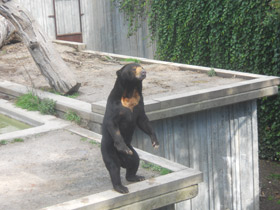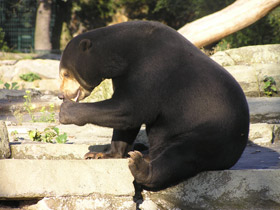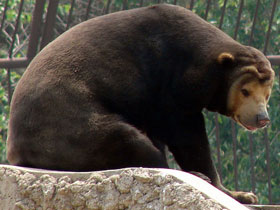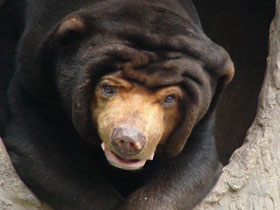The sun bear (Helarctos malayanus)
Sun bear видео
 The sun bear (Helarctos malayanus) is included in the IUCN Red List as a "vulnerable species"
The sun bear (Helarctos malayanus) is included in the IUCN Red List as a "vulnerable species"
The sun bear (Helarctos malayanus) is a species in the family Ursidae (the only species in the genus Helarctos) occurring in the tropical forests of Southeast Asia.
Appearance and habitat area
Helarctos malayanus is found in Borneo, Java, Sumatra and the Malay Peninsula. It inhabits lowland and mountainous tropical and subtropical forests, but can also be found in shallow swamp forests, as well as in mountainous areas at altitudes of up to 3,000 metres.
Helarctos malayanus is the smallest (weighing no more than 65 kg and having a body length of 1.5 m) and most aggressive of the bears. It is an animal with a rather long but unkempt torso, small ears, very small blind eyes and a short, waterproof coat. The paws of Helarctos malayanus are strong, the soles are bare and the claws are long, sharp and twisted.
A distinctive feature of Helarctos malayanus is its elongated and very agile snout, which, together with its long tongue, is perfectly adapted for termite prey. The unusually long tongue (for a bear) is probably an adaptation for retrieving honey and insects.
Nutrition and lifestyle
Like all members of its family, Helarctos malayanus is omnivorous. In addition to termites, it may eat fruit, earthworms, wild bees and other insects, as well as lizards, small mammals and birds. Bears sometimes damage coconut palms (by eating their tender shoots), banana trees and cocoa plantations.
Of all the bears, Helarctos malayanus spend the most time in the trees. With their long sickle-shaped claws on all four legs, they are excellent at climbing any tree, leaving distinctive marks on the bark of trunks. Helarctos malayanus is mainly active at night.
Reproduction
Sun bears are polyoestrous; births occur throughout the year. Oestrus lasts five to seven days. Sun bears become sexually mature at two to four years of age. Reported lengths for pregnancies vary from 95 to 240 days; pregnancy tends to be longer in zoos in temperate climate possibly due to delay in implantation or fertilisation. Births occur inside hollow tree cavities. A litter typically comprises one or two cubs weighing around 325 g (11.5 oz) each. Cubs are born deaf with eyes closed. The eyes open at nearly 25 days, but they remain blind till 50 days after birth; the sense of hearing improves over the first 50 days. Cubs younger than two months are dependent on external stimulation for defecation. Cubs are kept on buttress roots at the base of trees until they learn how to walk and climb properly. Mothers protect their cubs aggressively. Offspring remain with their mother for nearly the first three years of their lives. Lifespan in captivity is generally over 20 years; one individual lived for nearly 31 years.
Etymology
The sun bear is named so for its characteristic orange- to cream-coloured, crescent-like chest patch. The generic name Helarctos comes from two Greek words: ήλιος (hēlios, related to the sun) and αρκτος (arctos, bear). Another name is honey bear, beruang madu in Malay and Indonesian, in reference to its habit of feeding on honey from honeycombs. "Honey bear" can also refer to the kinkajou.
Taxonomy and phylogeny
The scientific name Ursus malayanus was proposed by Stamford Raffles in 1821; he first described a sun bear from Sumatra. In 1825, Thomas Horsfield placed the species in a genus of its own, Helarctos, when describing a sun bear from Borneo.
Subespecies
- Bornean sun bear (Helarctos malayanus euryspilus) - The Bornean sun bear occurs only in Borneo. Its skull is smaller than that of the Malayan sun bear.
- Malayan sun bear (Helarctos malayanus malayanus) - The Malayan sun bear occurs on the Asian mainland and Sumatra. Smallest member of the bear family.















































